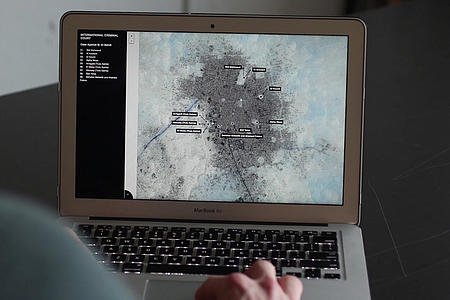Digital Evidence Platform developed by SITU used at International Criminal Court trial to help secure historic conviction
June 27th 2024FOR IMMEDIATE RELEASE: June 27, 2024 – Yesterday, a panel of three judges at the International Criminal Court (ICC) found Mr. Al Hassan Ag Abdoul Aziz Ag Mohamed Ag Mahmoud guilty of war crimes and crimes against humanity committed in Timbuktu, Mali in 2012 and 2013. During this period Timbuktu was occupied by Jihadist groups and Mr. Al Hassan served as the de facto chief of the Islamic police. A full account of the ruling can be found here.
The case marks the first time a defendant has been prosecuted and convicted for religious persecution. It is also the first time an ICC trial has featured the use of a digital evidentiary platform.
Produced by SITU Research for the Al Hassan case at the request of the Office of the Prosecutor, the platform featured a virtual reconstruction of the built environment of Timbuktu. Effectively a ‘digital twin’ of the city, it hosted a diverse array of both open-source and closed-source evidence such as videos, photos, 3D data, satellite imagery and more. The ability of the prosecution, defense and judges to spatially and temporally navigate the city and access evidence within a virtual 3D environment provided an intuitive method to help assess whether alleged violations were systematic and widespread–a fundamental criteria when determining whether a crime meets the thresholds established under International Law.
The use of the platform represents a shift away from how evidence has traditionally been accessed during trials at the ICC. Developed as an interactive tool, the platform allows an open ended user experience that allows stakeholders to query and navigate evidence through both space and time. SITU Director Brad Samuels said the following:
The goal was to produce a tool capable of hosting multiple evidentiary formats within a single register. In a data saturated environment, it becomes increasingly important to provide platforms that allow a single piece of evidence, like a video or a photo, to be understood in relation to other contextualizing information. In this case, to understand the where and when of the alleged crimes, the built environment of Timbuktu became an organizing principle that was helpful in understanding and communicating patterns of violence over an extended period of time.
Building on SITU’s prior collaborations with the ICC, the digital platform developed for the Al Hassan case has set an important precedent for the use of such formats at trial. In a recent essay titled "Innovation and Technology in Building Modern Investigations and Prosecutions at the ICC,"¹ Chief Prosecutor Karim Khan reflects on the use of this platform:
The potential advantages of this way of presenting such evidence are manifold and may include: avoiding the necessity of certain potentially dangerous site visits for the judges; presenting evidence to the judges in a user-friendly and accessible manner; and enabling witnesses in the courtroom to discuss relevant evidence in a more comprehensive way. Trial Chamber X’s acceptance of the platform shows that the law and procedure of the ICC is ready to accommodate forward-thinking approaches to the presentation of evidence.
Notably, counsel representing Mr. Al Hassan did not challenge the use of the platform themselves, provided that all evidence presented therein would be admitted into evidence separately. Indeed, the defense sought full access to the virtual platform, and required (and were provided) training and guidance on its use, so that they could also deploy it as needed. As noted by Trial Chamber X, the parties reached mutual agreement with regard to the defense’s access to the platform.
Yesterday’s verdict at the ICC presents an important moment of closure for victims, witnesses and family members in this case. While the use of the digital platform is a small detail in terms of the substance of this trial, it is a precedent that can be built upon for casework moving forward and an important milestone in the integration of new technologies, methods and formats for how digital evidence is considered in the courtroom.
¹Khan, Karim. "Innovation and Technology in Building Modern Investigations and Prosecutions at the ICC.” The International Criminal Court in Its Third Decade: Reflecting on Law and Practices, vol. 109, 2023, pp.107.



